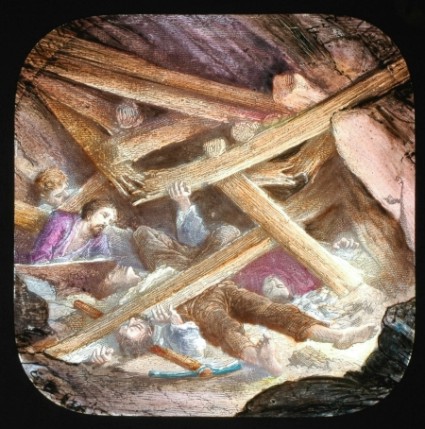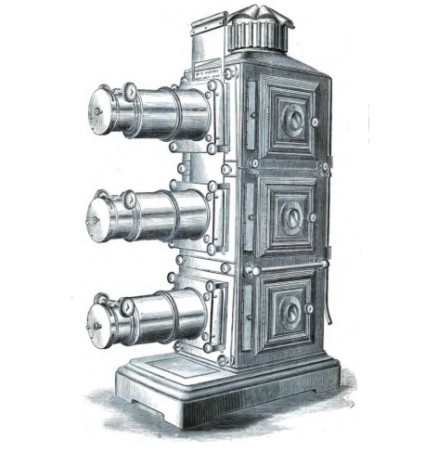Slide 9 from The Miner’s Rescue (W. Rider & Co), Hecht Collection, Screen Archive South East, from the Lucerna database
Time may move in a straight line, but history does not. Despite the beliefs of the more traditional writers of history, particular themes seldom roll out as a succession of sequential events leading to a satisfactory conclusion. Film, or media history, for example, is not a case of one innovation neatly being followed by another, then another, leading to the media world with which we are familiar today. There are overlaps, reverses, diversions, false trails, parallel actions, missed opportunities, and all manner of divergent yet interconnected narratives. So, the historical argument that says there were optical toys, magic lanterns, chronophotographs and such like (bundled up in neat teleological fashion as ‘pre-cinema’), which were then followed by the cinema, the goal towards which so-called pre-cinema was inexorably aiming, is, quite simply, a-historical.
This we can see with the magic lantern, whose history has been opened up as never before by the publication of the Lucerna database, a new resource of some significance. Launched yesterday at the Screen Culture and the Social Question: Poverty on Screen 1880-1914 conference in London, Lucerna is an online database and information resource for the magic lantern. Magic lanterns are generally thought of as Victorian entertainments which prefigured the cinema. One of the things that Lucerna makes very clear is how the lantern did not die out once the cinema arrived, but that the two media co-existed for many years, with showmen employing both, production companies and distributors supplying both, and journals (such as The Kinematograph and Lantern Weekly, which lasted under that name until 1917) serving both. To understand early cinema, we need to understand the magic lantern too.
Lucerna is dedicated to the history of the lantern, in all its forms, reflecting its many relationships with social, political, religious, entertainment and cinema history. As the site says:
For more than 350 years the magic lantern has represented and fed into every aspect of human life and every part of the world. It is still used today, both in its original form and through direct descendants like the modern data projector.
The centrepiece of Lucerna is a database of slide sets, individual slide images, readings and other texts related to slide sets, lantern hardware, people and organisations involved in lantern history, locations associated with lantern production, and events. There is at present information on 6,332 slide sets (i.e. a set of images relating a particular narrative), 26,475 individual slides, 3,687 people and 1,366 organisations connected with lantern history. Many of the records are illustrated with slides from public and private collections, and browsing through the Slides and Slide Sets options is a marvellous way of viewing the preoccupations, beliefs and diversions of Victorian and Edwardian society (the slides available so far are predominantly British, though the lantern was of course a worldwide phenomenon).
Complete life model slide set for Beware!; or, The Effects of Gambling (Bamforth, 1893)
Lucerna does not have a single search option. Instead you are offered nine search options: slide sets, slides, people, organisations, events, locations, hardware, texts and keywords. Each offers a range of search parameters; Slide Sets, for example, lets you refine your search by country, manufacturer (with drop down menu for every manufacturer listed – indeed every search field under every option has a drop-down menu, so you never have to select any name or term at random), type of slide subject, type of image, date, and series title. Results can be ordered by title, date or series order, and crucially you can search under slide sets for those where there are images available, which is what most users of the site are going to want to do. Unfortunately you don’t seem to be able to do this for individual (‘orphan’) slides. Each individual record (and there ae tens of thousands of them) very usefully comes with a unique Lucerna ID number.
The best thing to do is to jump in at any point and start browsing, because such is the depth of hyperlinking that you are led inexorably from page to page, following themes, places or people as you construct your personal journey through lantern history. It soon becomes clear that this is a bit beyond your average database. It’s not obsessive as such, but it’s certainly in thrall to the richness of its subject. Person entries include not just birth/death dates and occupation, but references to census records and other archive sources, associated slides or texts, locations associated with them, businesses associated with them, literature references – and all of this with hyperlinks to everything mentioned. So, I find at random the record for Charles Acres, a partner in a slide painting business, and see that he was born in Islington. There’s a hyperlink – and lo I find there are seventeen lantern people associated with Islington (14 born there, 3 died there), one business located there, and one entry which reports on a lantern show which tooks place there, organised by the Sunday School Union. Click on that, and a huge list of events appears, all of them hyperlinked and described. And so the adventure continues.
(One searching tip – don’t hit the ‘go’ option on any search page without having put in at least one search term. Failing to do so appears to set the database into endless searching mode)
Slides from a 1911 Bamforth set to accompany the song ‘Are there any little angels blind like me?’
Themes that will soon become apparent are family, religion, the sufferings of the poor, temperance, war, empire, humour, gambling, travel, crime, patriotism, morality, romance, the supernatural and travel. Many are sentimental, and lead you to think how much audiences of the time were swayed by such images. Most tell stories of one kind or another, or illustrate songs with visual narrative, and the parallels with early films, in subject and tone, is immediately noticeable. Some slide sets, such as Ora Pro Nobis or Ostler Joe (each based on poems), later became films, and one sees not separate media histories, but rather the way in which a society wanted to see stories told, and the means that then developed technologically to make this happen.
A triunial or triple lantern (W.C. Hughes, 1880s)
Lucerna has been developed by the Universität Trier in Germany; Screen Archive South East, University of Brighton, UK; the Magic Lantern Society, UK; and Indiana University in the USA. However it is predominantly the work of one man, both in its programming and in the population of data, Richard Crangle, to whom the lantern world in particular and anyone in general at all interested in sceen culture and the worlds that screens depict should be hugely grateful. Crangle has set out not simply to display lantern images (as many other sites do), but to present the lantern in its many contexts, rigorously described, as a research resource. The ambition of the site is to encourage lantern enthusiasts to share their collections and knowledge, which they can do openly or anonyously as they wish, by signing up to the site and contributing information or images. So Lucerna is meant to be a collective, Wikipedia-like endeavour, and one hopes very much that it is able to be developed along such co-operative means.
If Lucerna whets your appetite for more information on the magic lantern (which it is bound to do), then here are a few links to encourage you to explore further:
- The Magic Lantern Society – much information, well-illustrated, on lantern history, lanterns and slides
- The Projection Box – distributors of Magic Lantern Society publications, including the indispensible Encylopedia of the Magic Lantern
- Screening the Poor 1888-1914 – a double-DVD of early films and magic lantern slide sets on the theme of poverty, available from Edition Filmmuseum (reviewed by the Bioscope here)
- Laterna Magica – Magic Lantern vol. 1 – a bi-lingual (English/German) illustrated history of the lantern in the 17th and 18th centuries, by Deac Rossell
- Visual Media – heavily illustrated site by Thomas Weyants on ‘pre-cinema’ visual media, including magic lanterns, phantasmagoria, optical toys etc.
- Museo del Precinema – Italian museum with extensive lantern resources, home of the Minici Zotti collection
- Magic-Lantern.eu – large Dutch collection of lantern slides and equipment, handsomely illustrated
Lucerna is still in its early days, with the eventual aim of becoming the single definitive and comprehensive illustrated resource for the magic lantern. If enough of the lantern community join in and help Richard Crangle in his stupendous task, it may become so. But Lucerna is not just for the lantern specialist. The hope is to bring the lantern back into general consciousness, and to reintroduce it into those histories of screens, society, art, leisure, politics, religion and culture, where it most certainly belongs.
Go explore.




And 2,000 glass slides from Museo Nazionale del Cinema Torino (italian-english) here:
http://www.museonazionaledelcinema.it/collezioni/LanternaMagica.aspx?l=en
Bravo! Just happened upon this blog, and i am deeply in love and in search of Magic Lantern information & images. Thank you emphatically
If a blog could blush, this one would.